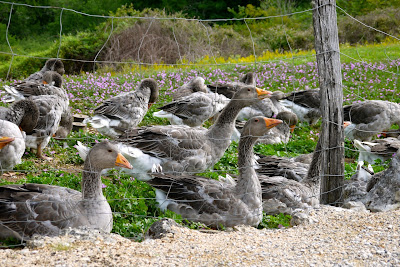The Dordogne is a simply beautiful area of France, crammed full of beautiful towns and villages and castles and chateaux to rival the Loire Valley. Will give you some highlights of our few days there.
Near Montignac, we went to Lascaux II, to see the prehistoric cave paintings discovered in nearby Lascaux in 1940. Apparently four teenage boys were out with their dog, who fell down a hole into a cave. Being teenage boys, they rushed home to get lamps so they could explore the cave and discovered the paintings from 17,000 years ago. The cave became known as the Sistine Chapel of Pre-History and the images on the walls and ceilings are of bulls, horses, deer and ibex. The cave rapidly became a major attraction but the influx of visitors allowed harmful micro-organisms into the cave which had been closed for so long, which caused the paintings to deteriorate and the cave was closed in 1963. The local authority then created an exact replica of the cave and the paintings, 200 metres from the originals. They're incredible - the colours are still very vibrant and the drawings incredibly sophisticated. No photos for you because they're copy-righted.
Along parts of the Dordogne Valley there are castles on every cliff top. Their strategic positions meant that they were under heavy attack during the Hundred Years War between England and France and regularly changed hands.
We drove up to the tiny little village of Cazenac and had the lovely experience of meeting and talking with an old man in the graveyard there. He was delightful. He told us about the area and took us into the church to explain the stained glass windows (created in the '70s), which all feature local people, including him and his wife who'd recently died, just short of 60 years of marriage. Much more interesting than the normal Madonna and child.
La Roque-Gageac is a town built against a rock cliff, which drops vertically down to the Dordogne River. There's clear evidence of the day in 1957 when a huge block of rock came away from the cliff face, destroying a dozen homes and killing three people.
One of the highlights of the Dordogne was the Hanging Gardens of Marqueyssac. It's a private estate built on a cliff high above the valley. It originally belonged to a guy who'd spent time in Italy and wanted to replica an Italian garden, complete with pruned boxwoods of all shapes and forms. They're hand-clipped twice a year, once in spring and again in late summer - given their states of perfection, I'm surprised that's all. Much of the topiary is rounded and you have the sensation almost of floating when you look at it. The château is late 18th century, built on the eve of the French Revolution. It has an incredibly beautiful roof made from limestone slabs, typical of the region - weighs more than 300 tons!
And St Cirque-Lapopie is yet another lovely little town. We were there in 1994 and it was just as pretty this time around and surprisingly, it's still not overrun with tourists. It's on a sheer cliff above a river - a truly spectacular setting.
Rocamadour is a mass of old dwellings, oratories and towers on the face of a cliff, 150 metres above the river. It's a historic site and a place of pilgrimage. There are 223 steps up the Great Stairway to the Ecclesiastical City; pilgrims made this ascent kneeling at every step. We went up them somewhat quicker I suspect.
The Dordogne's known for its foie gras and you see lots of geese with massively distended livers waddling around the place. And in the south of the Dordogne, you see massive fields of sunflowers. Unfortunately, we were just a couple of weeks too early to see them - a few hardy ones had blossomed but they'll be a magnificent sight in a few weeks' time.







No comments:
Post a Comment